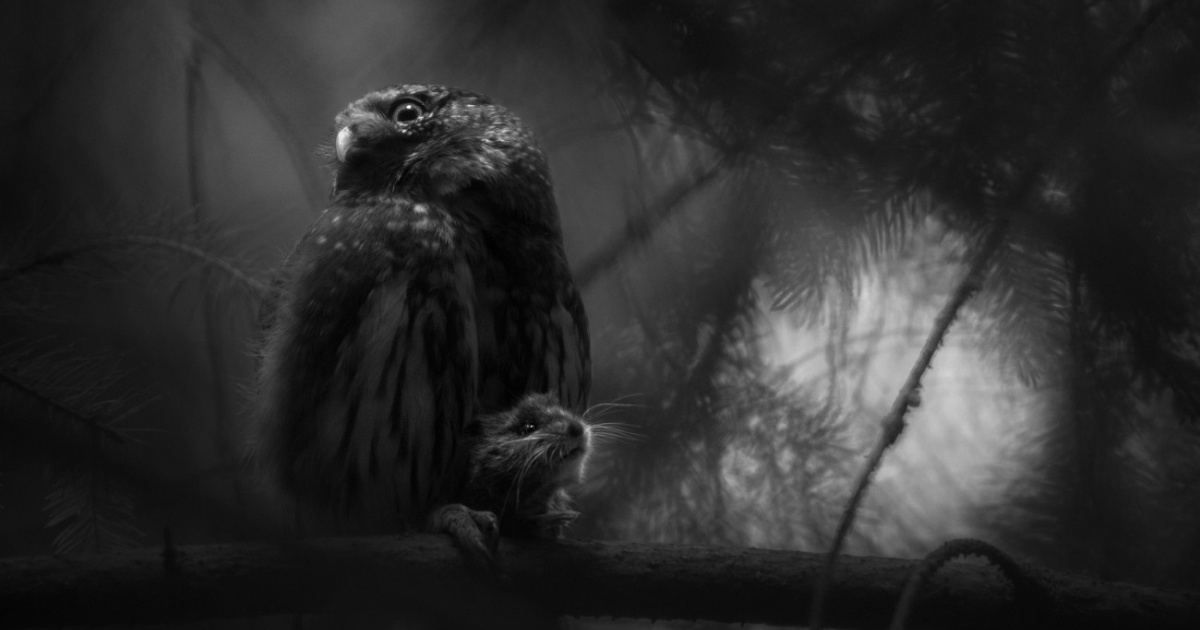
“Silent Despair” by Luca Lorenz (Germany). Winner, European Wildlife Photographer of the Year.
“Silent despair — not only from the mouse’s perspective! For many days, I observed from a distance a tree cavity deep in a German forest, where a pair of pygmy owls (Glaucidium passerinum) was nesting. One day, the female disappeared — she had probably been killed by a tawny owl or a hawk. When the young birds left the nest cavity about a week later and perched on the branches, still unable to fly, the male had great difficulty caring for them alone.
The morning after their first night outside, I found the male holding a mouse in his talons. For minutes. An unusual scene: he made no attempt to eat it — it was clearly meant for the chicks. Again and again, the male called for them, but there was no answer. I felt that I could see the despair in his searching eyes as I took this picture. The young birds never returned. They had probably fallen prey to a predator during that first night. It was heartbreaking for me to witness this situation.”
A heartbreaking look at the realities of parenthood in the wild won the 2025 European Wildlife Photographer of the Year contest. Photographer Luca Lorenz took the moving photo of a male pygmy owl returning with a meal for his young, only to discover they were no longer in the nest. The 20-year-old photographer from Berlin became the youngest overall winner in the competition’s 25-year history.
Lorenz’s win is all the more impressive given the record number of entries this year. Almost 24,500 images were submitted to the contest by amateur and professional photographers from 48 countries. An international jury of five members deliberated for three days to award 107 images across nine categories, as well as two special prizes, including the Rewilding Europe Award. Among all of the incredible photos, Lorenz—who is surprisingly self-taught—found himself with the submission that stood apart.
“During our long journey through light, color, drama, and action, a quiet, almost restrained image caught our attention,” recalls award-winning wildlife photographer and jury member Bruno D’Amicis. “Suddenly, we found ourselves transported out of the chaos of the world directly into a resin-scented spruce forest. The photographer grants us insight into the hidden life of a silent, inconspicuous creature—an animal that reveals itself only to those who bring patience and respect. It is a timeless story of life and death, told without brutality or blood, without winners or losers, without moral judgment. A nuanced, gentle reminder that there is no evil in nature.”
All the winners were announced at a special ceremony held during the GDT International Nature Photography Festival. The German Society for Nature Photographers (GDT) organizes the competition, which is open to its members as well as any photographer resident in Europe. A complement to its Nature Photographer of the Year contest, this photo competition highlights the incredible work of GDT photographers and wildlife photography in general.
Scroll down to see some of our favorite winners and then head to the official website to explore the winners’ gallery.
The 2025 European Wildlife Photographer of the Year contest has announced its winners.

“At the top of the food chain” by Audun Rikardsen (Norway). Runner-up, Birds.
“Highly toxic pollutants can persist in the environment for long periods of time and accumulate in the fatty tissue of both humans and wildlife — with species at the top of the food chain particularly affected. Among top predators, orcas (Orcinus orca) are known to have the highest contamination levels in the marine environment. This white-tailed eagle (Haliaeetus albicilla), also an apex predator, may not have made the wisest choice in feeding on a dead orca washed ashore during a harsh winter in northern Norway.”
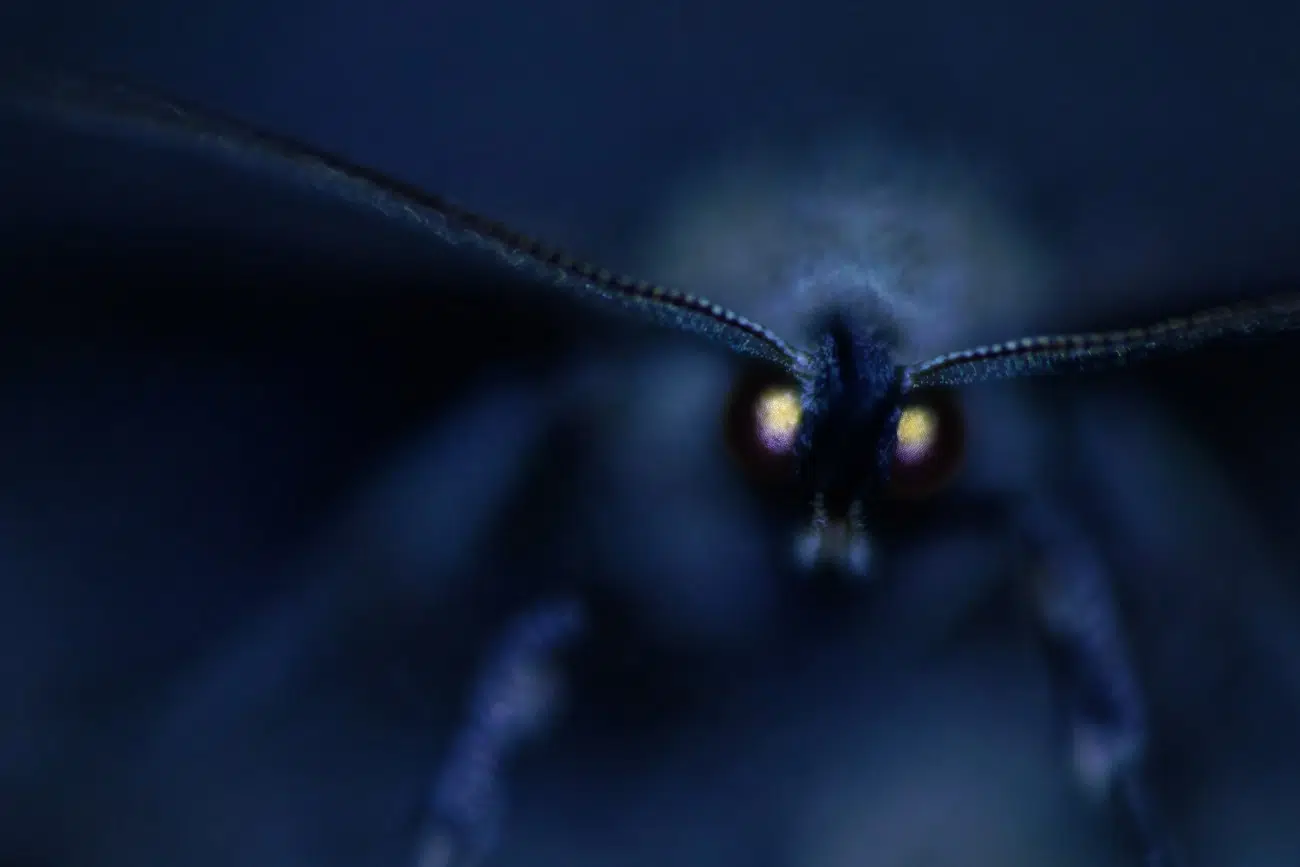
“Night vision” by Ivo Niermann (Germany). Runner-up, Other Animals.
“Many nocturnal species possess what is known as a tapetum lucidum, a biological adaptation that enhances their vision in the dark. When illuminated by a torch or spotlight, the eyes of these animals shine in characteristic hues—provided the lighting is nearly coaxial. Interestingly, a number of insects and spiders also exhibit this effect, even though their compound eyes are structurally very different from those of mammals. This image shows a noctuid moth (Noctuidae). To photograph this small-scale phenomenon, I constructed a custom light source.”

“Maternal embrace” by Alex Hyde (UK). Highly Commended, Other Animals.
“In Yasuní National Park (Ecuador), I came across this female centipede (Scolopendra sp.) wrapped protectively around her newly hatched young. Any predator attempting to threaten her brood risks an extremely painful bite. Observing parental care in invertebrates helps us appreciate these organisms in a new light—as complex, fascinating beings exhibiting a rich array of behaviors.”
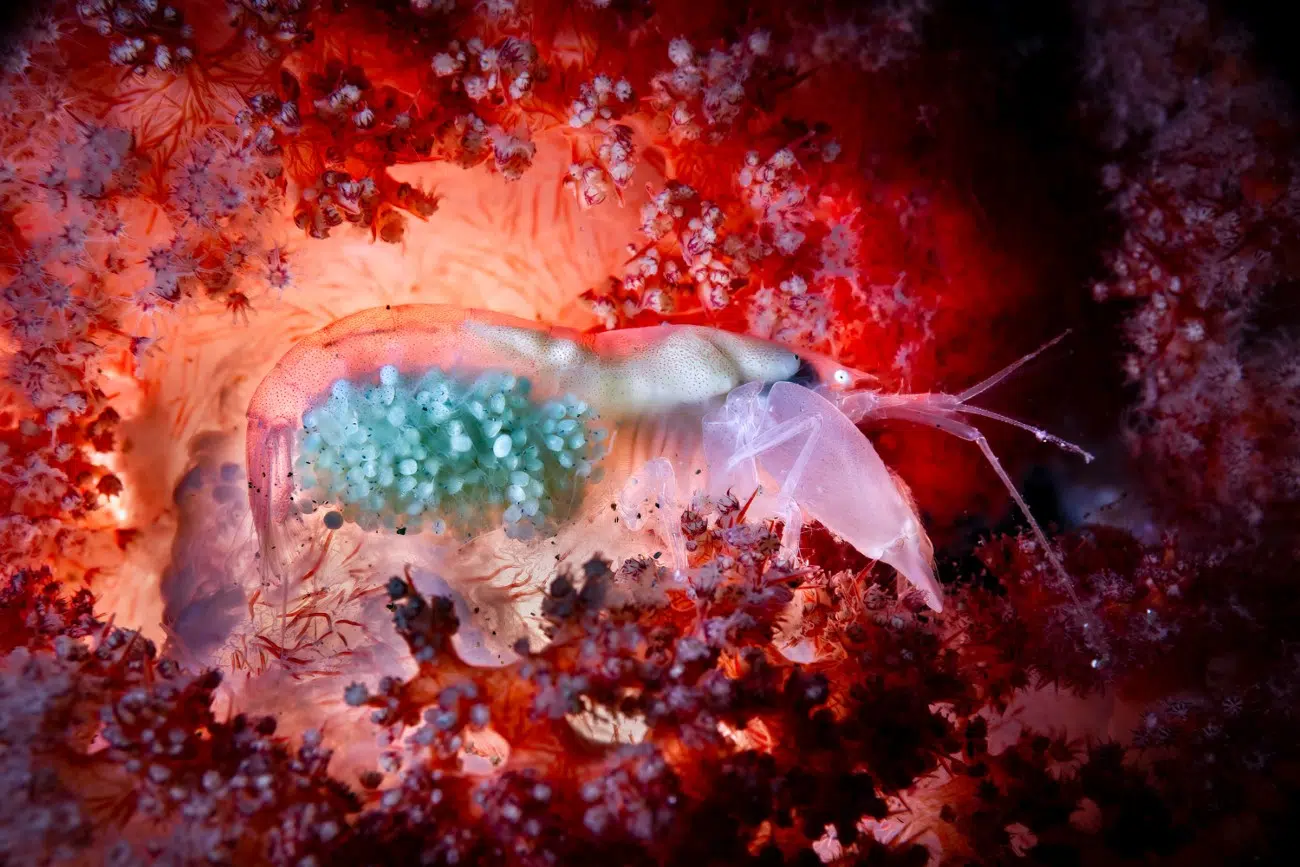
“Sea of Fire” by Andrea Michelutti (Italy). Highly Commended, Underwater World.
“I discovered this shrimp carrying the seeds of new life during a dive off the coast of Anilao, Philippines. Using a strobe with a snoot to backlight the red coral, I created the impression that the shrimp was sitting in a lava flow.”
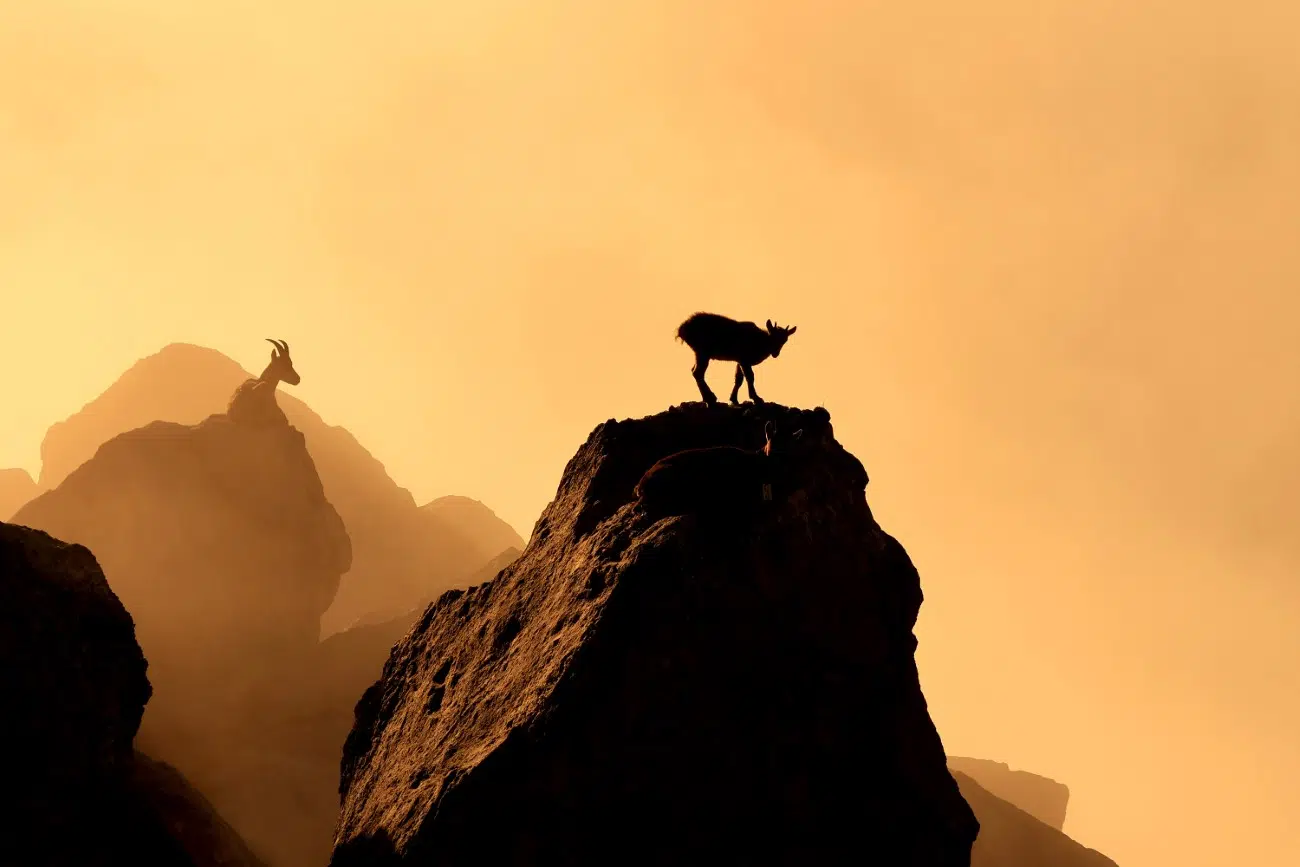
“At dawn” by Lubin Godin (France). Winner, Young Photographer | 14 years and under.
“A quiet August morning at Col de la Colombière, France. A gentle mist envelops a group of Alpine ibex (Capra ibex) resting on a rocky outcrop. Among the ibex is a lively kid, brimming with energy and repeatedly climbing up and down the rocks. It reminded me of a young child, eager to play while its weary parents attempt to get a few winks of sleep.”
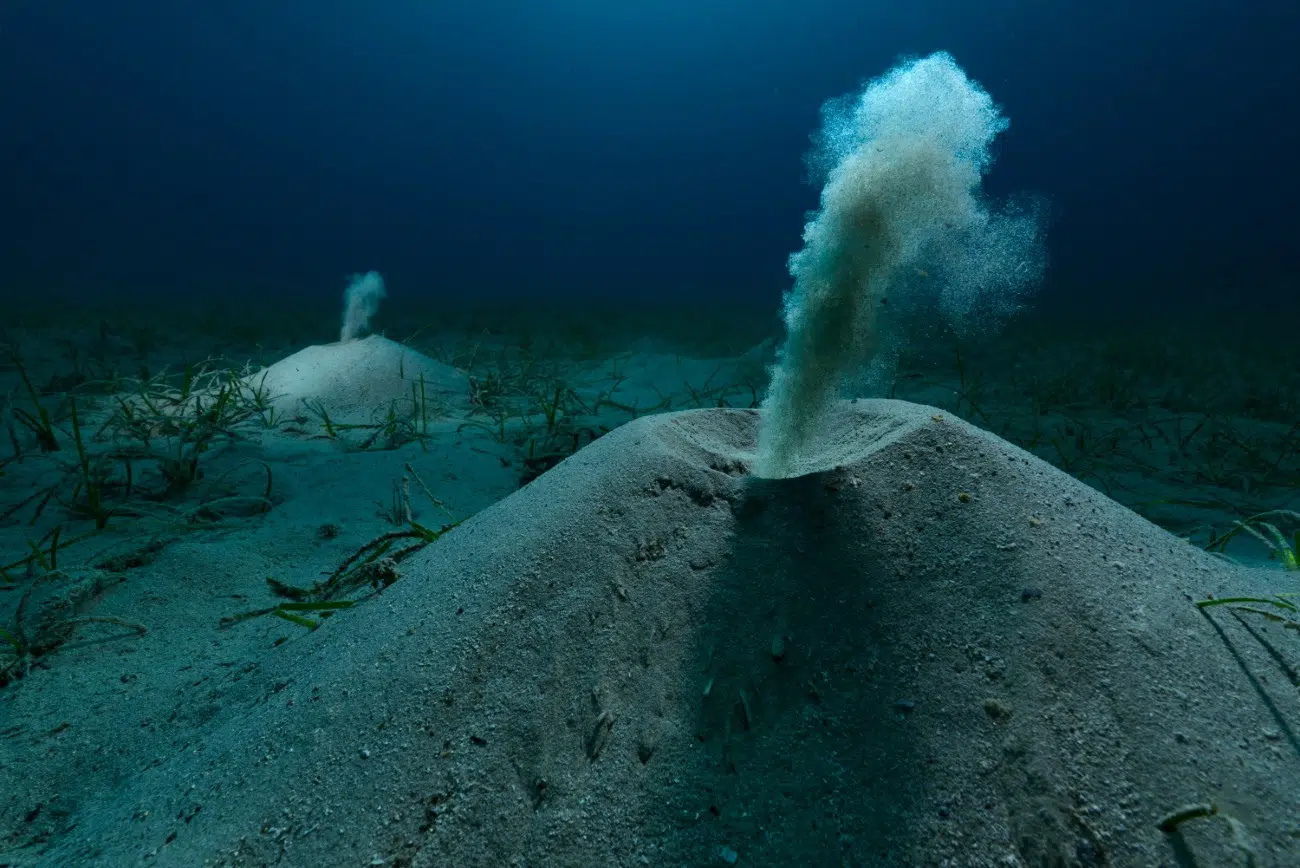
“Unsung Heroes” by Angel Fitor (Spain). Winner, Underwater World.
“Two polychaete worms expel sand from their burrows in a seagrass meadow in the Mediterranean Sea by Spain. As members of the infauna, a vast and diverse community adapted to underground life at sea – these burrowing worms play a pivotal role in maintaining oxygen and nutrient circulation in the upper layers of seabed sediments, an activity that generates an entire ecosystem hidden under the substrate. The world’s seagrass beds, the riches of coastal estuaries and deep-water mudflats, and the vast species richness of soft-bottom sea floors rely on the existence of these unsung heroes. Their collective, silent action has a significant impact on the global scale. On location, it was not unusual to witness a plume of sand escaping from one of the worms’ volcano-shaped mounds. Capturing two at once, however, was another matter entirely. To take this shot, I completed twenty dives over the course of two months, each lasting five hours, lying motionless at a depth of 8 m, waiting for the moment I had envisioned.”
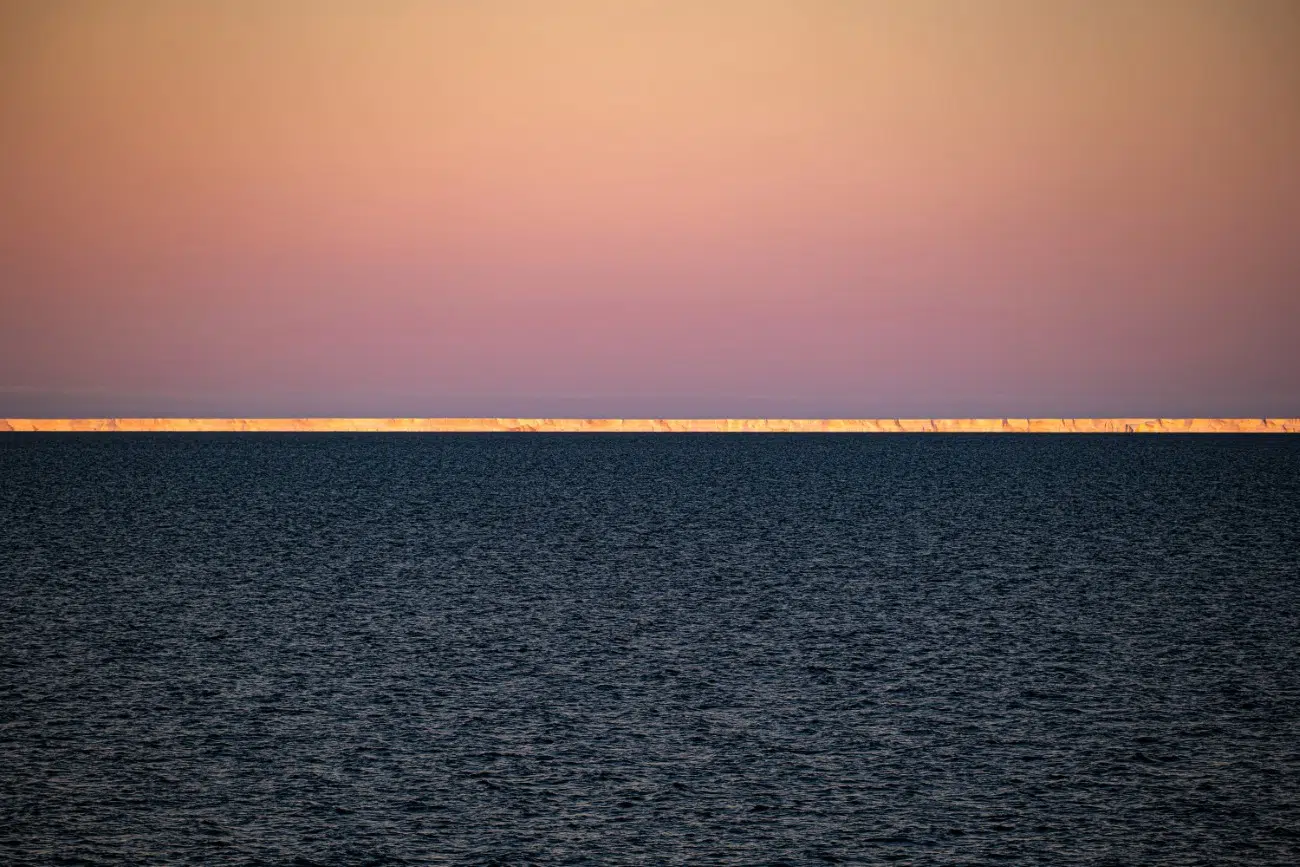
“Minimalistic triad” by David Menzel (Germany). Winner, Landscapes.
“This photograph was taken aboard an icebreaker during a research expedition to Antarctica. The sun had reached its lowest point during the polar day, casting golden light on the edge of the Shackleton Ice Shelf in East Antarctica. During the voyage, I came to appreciate the beauty of simplicity. Although minimalist in composition, this image captures the essential elements of Antarctica’s climate system: atmosphere, ice, and ocean – and the quiet complexity of their interactions.”

“Swan lake” by Terje Kolaas (Norway). Winner, Birds.
“Most lakes and rivers in my home district freeze over completely in winter. However, one particular river stays ice-free just a little longer than the rest. As a result, this river becomes a gathering place for many waterbirds including whooper swans (Cygnus cygnus). On a cold February day, heavy snowfall transformed the forest into a white, ethereal landscape with the dark, flowing river in the foreground. To capture all the delicate details of the scene, I used a drone and then selected a shutter speed of 1/25s to visualize the motion of the falling snowflakes.”

“War is near” by Hannu Ahonen (Finland). Winner, Nature’s Studio.
“On a frosty morning, I wandered through the abandoned buildings near my home, searching for frost patterns on windowpanes. One window had a bullet hole decorated with intricate ice crystals. The pane instantly made me think of the war in Ukraine. To me, this pattern resembles a beautiful, faceless angel of death, come to collect the victims of war—a chilling reminder of how close this conflict truly is.”
Almost 24,500 images were submitted to the contest by amateur and professional photographers from 48 countries.

“Amongst the stars” by Tibor Litauszki (Hungary). Winner, Other Animals.
“A few days after the common frogs (Rana temporaria) had laid their eggs, alpine newts (Ichthyosaura alpestris) began to appear at dusk to feed on the spawn. I wanted to capture this extraordinary moment underwater. To do so, I placed my camera in an underwater housing, secured it with weights, and positioned it beneath the frog spawn after manually focusing the lens. I waited until nightfall. When the newt arrived, I illuminated it with an LED and took the shot. The camera was triggered via a shutter release cable.”

“Forensics” by Britta Jaschinski (Germany). Winner, Man and Nature.
“What appears to be a fascinating underwater image of a green sea turtle (Chelonia mydas) is in fact a forensic method that can help bring poachers and illegal wildlife traffickers to justice. Special fluorescent dyes photographed under ultraviolet light reveal fingerprints, blood and other bodily fluids, gunshot residue, and much more. Dr A. Thomas and L. Gibson from Wildlife Crime and Forensics at the Zoological Society of London are developing these techniques to support law enforcement. All seven species of sea turtle found across the globe are listed as threatened, endangered or critically endangered due to a combination of human persecution, habitat destruction, and marine pollution.”
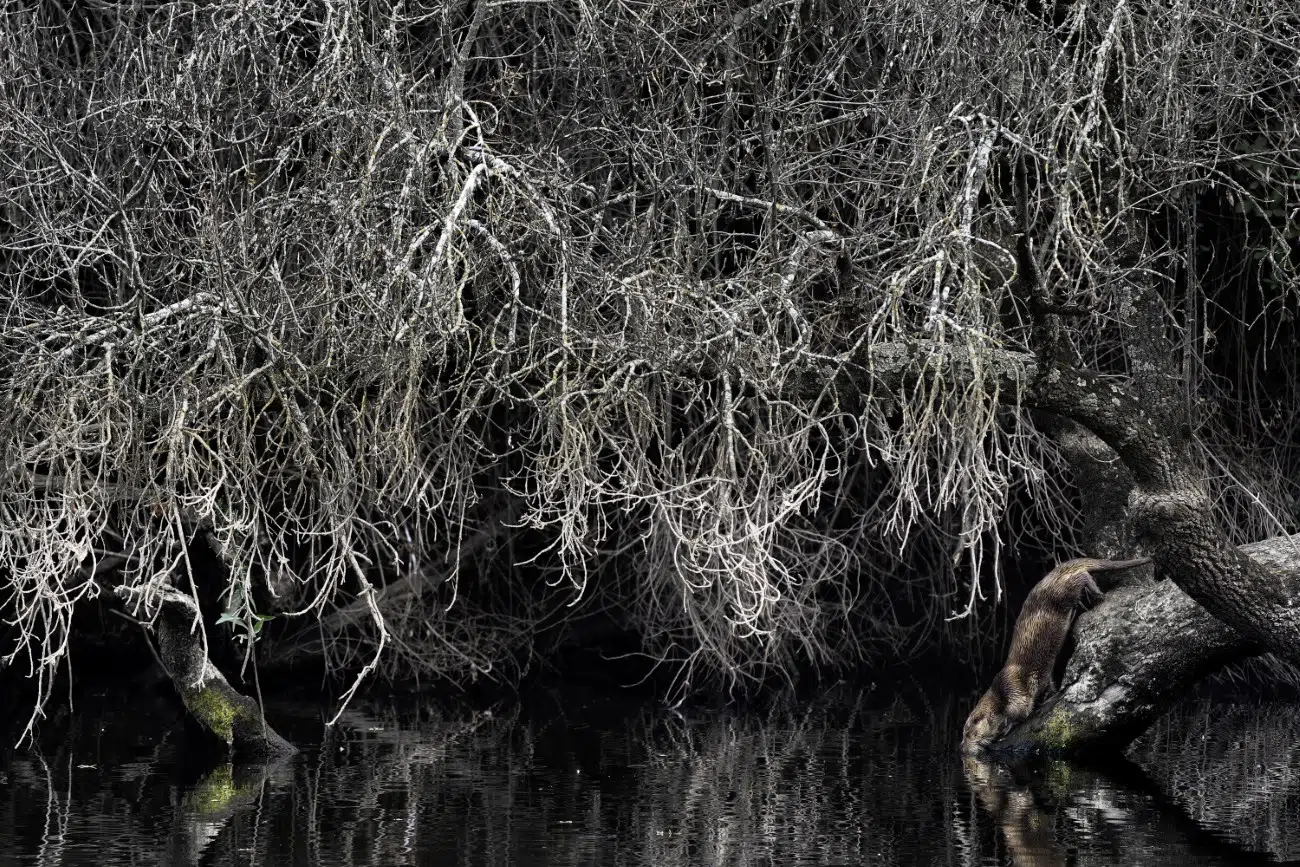
“Time for a swim!” by Federica Cordero (Spain). Winner, Mammals.
“I originally traveled to Andalusia, Spain, with the goal of photographing Iberian lynx. On my second day, I was told that a lynx had been sighted near a river. I never spotted the lynx—but instead, I encountered a family of Eurasian otters (Lutra lutra) hunting in the river. Otters are superb swimmers and agile, accomplished fishers. This image captures an adult just after finishing a meal and poised to slip back into the water—its true element. I was particularly drawn to the monochrome, fairytale-like riverbank vegetation which formed the perfect stage for the otter’s elegant presence.”
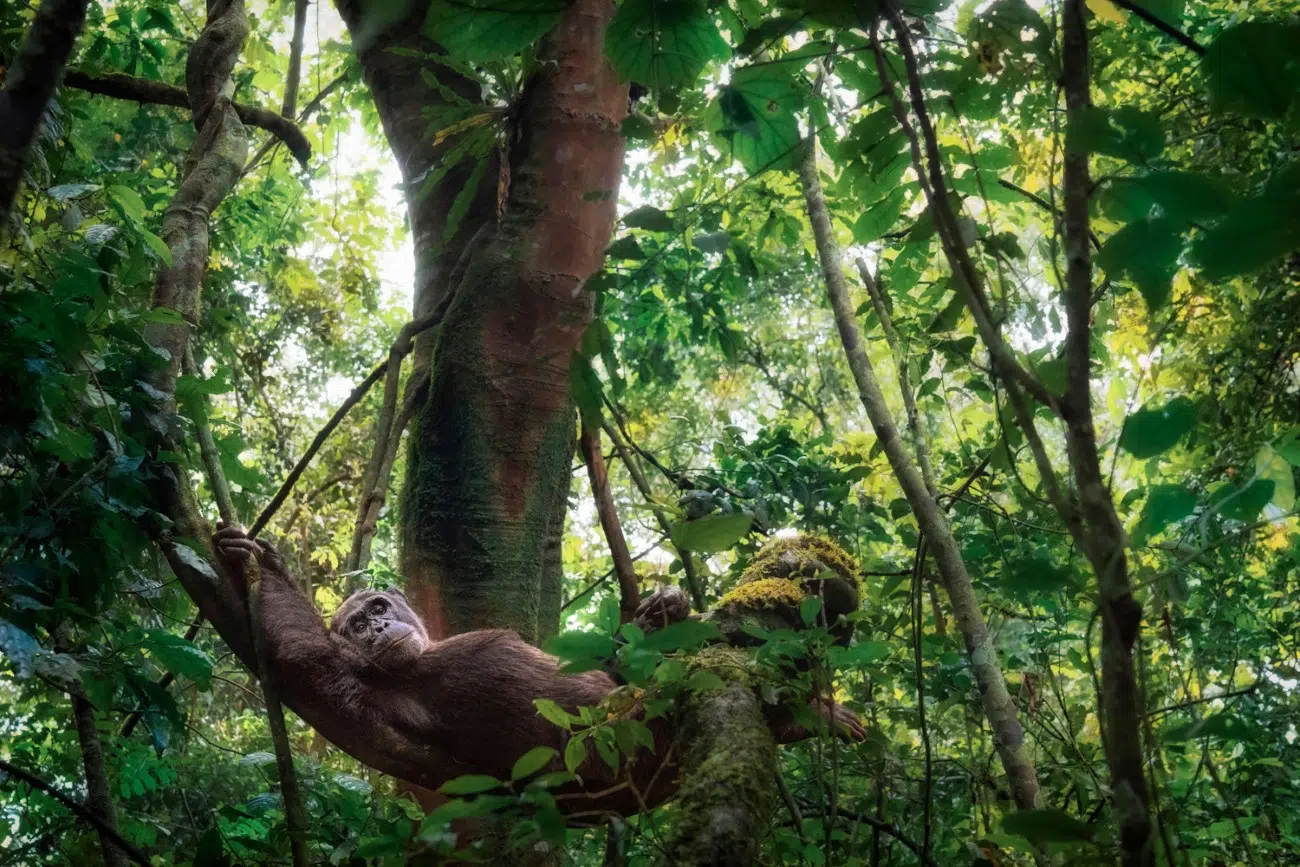
“Hammock in the jungle” by Federica Cordero (Italy). Highly Commended, Mammals.
“This image was taken in Uganda’s Kibale National Park, famed for its chimpanzees (Pan troglodytes). Soon after our arrival, we spotted an entire family feasting in the crown of a large fig tree. Just as we were about to leave, a young, self-assured male monkey approached us. He behaved like a top model, posing confidently for over an hour, allowing me to capture a wide range of fascinating shots.”
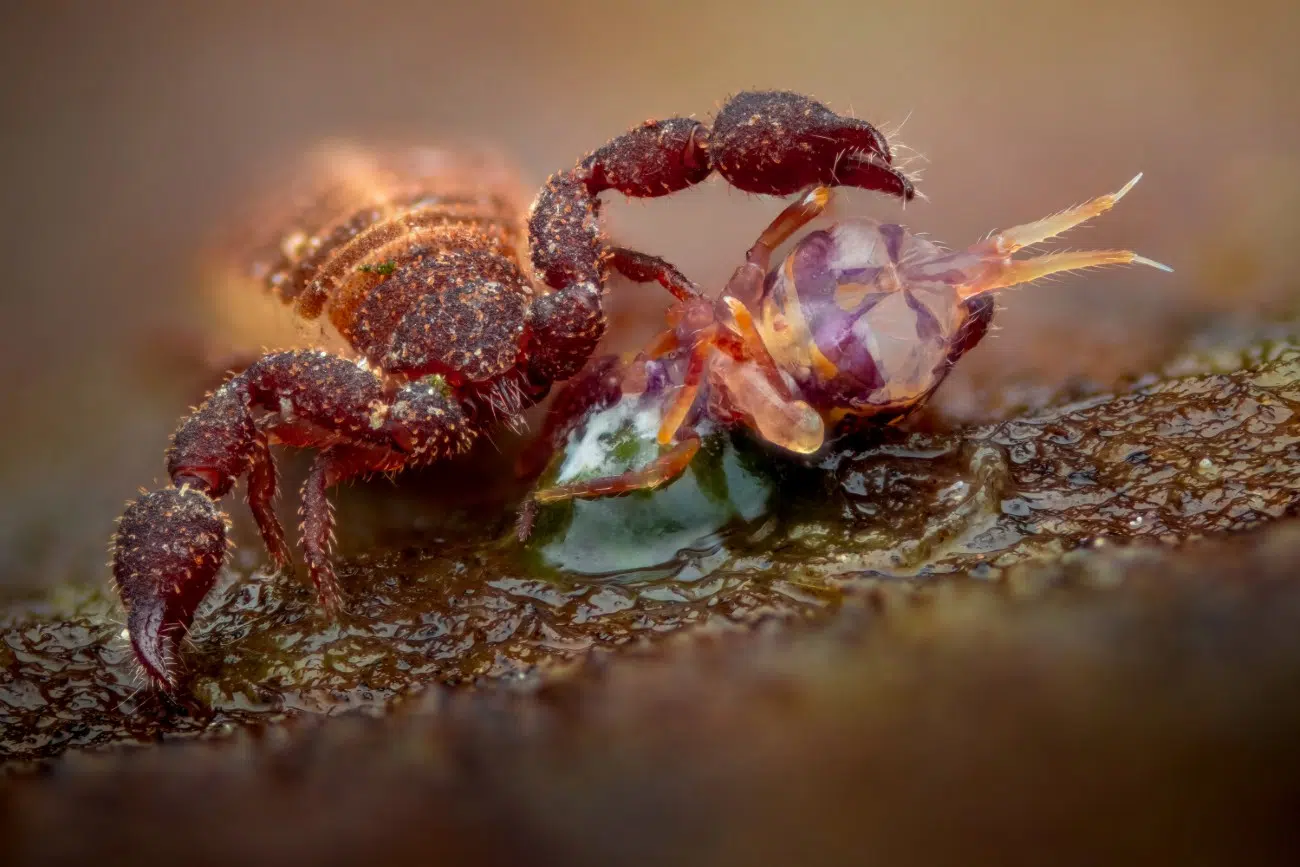
“Predator” by Alexis Tinker-Tsavalas (Germany). Winner, Young Photographer| 15-17 years.
“During an early spring photo excursion, I came across a pseudoscorpion (Chernes cimicoides) preying upon a springtail. Having never photographed such a moment before, I was determined to capture as much detail as possible. Shooting from a low angle, I took 104 exposures at varying focal depths, later combining them via focus stacking. This technique enabled me to achieve a far greater depth of field than would have been possible with a single image.”
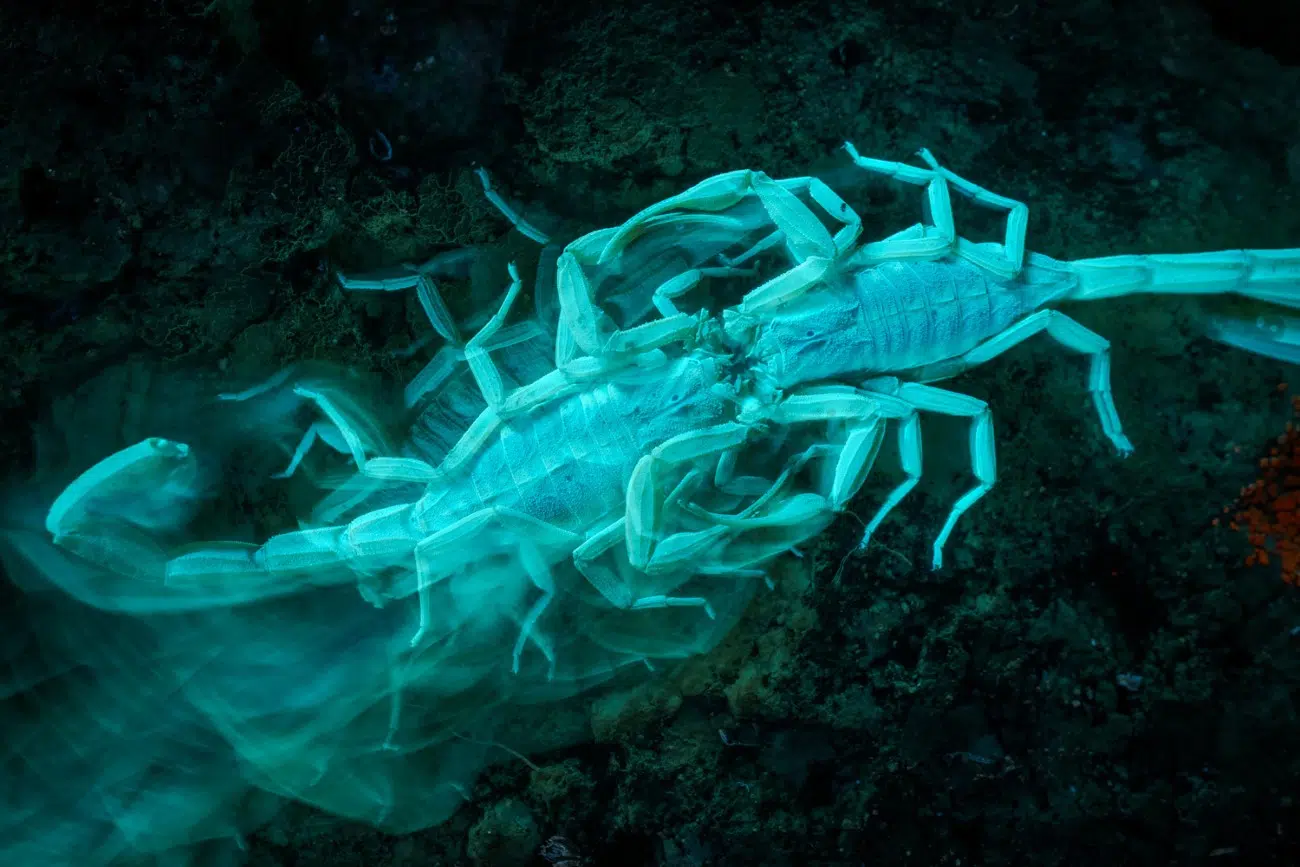
“Moonlight dance” by Javier Aznar (Spain). Highly Commended, Other Animals.
“Beneath the glow of an ultraviolet torch, a fascinating courtship ritual unfolds between two Arizona bark scorpions (Centruroides sculpturatus) in the desert (New Mexico, USA). The pair performs an intricate dance, known as a ‘promenade’, during which they grasp each other’s pincers and move gracefully in unison. This ritual is not only a spectacle of elegance, but also a vital exchange: the female assesses the male’s strength, stamina, and overall health—traits essential for siring viable offspring. Meanwhile, the male showcases his vigor in hopes of securing a mate. This captivating spectacle highlights the complex behaviors and evolutionary strategies of scorpion courtship.”
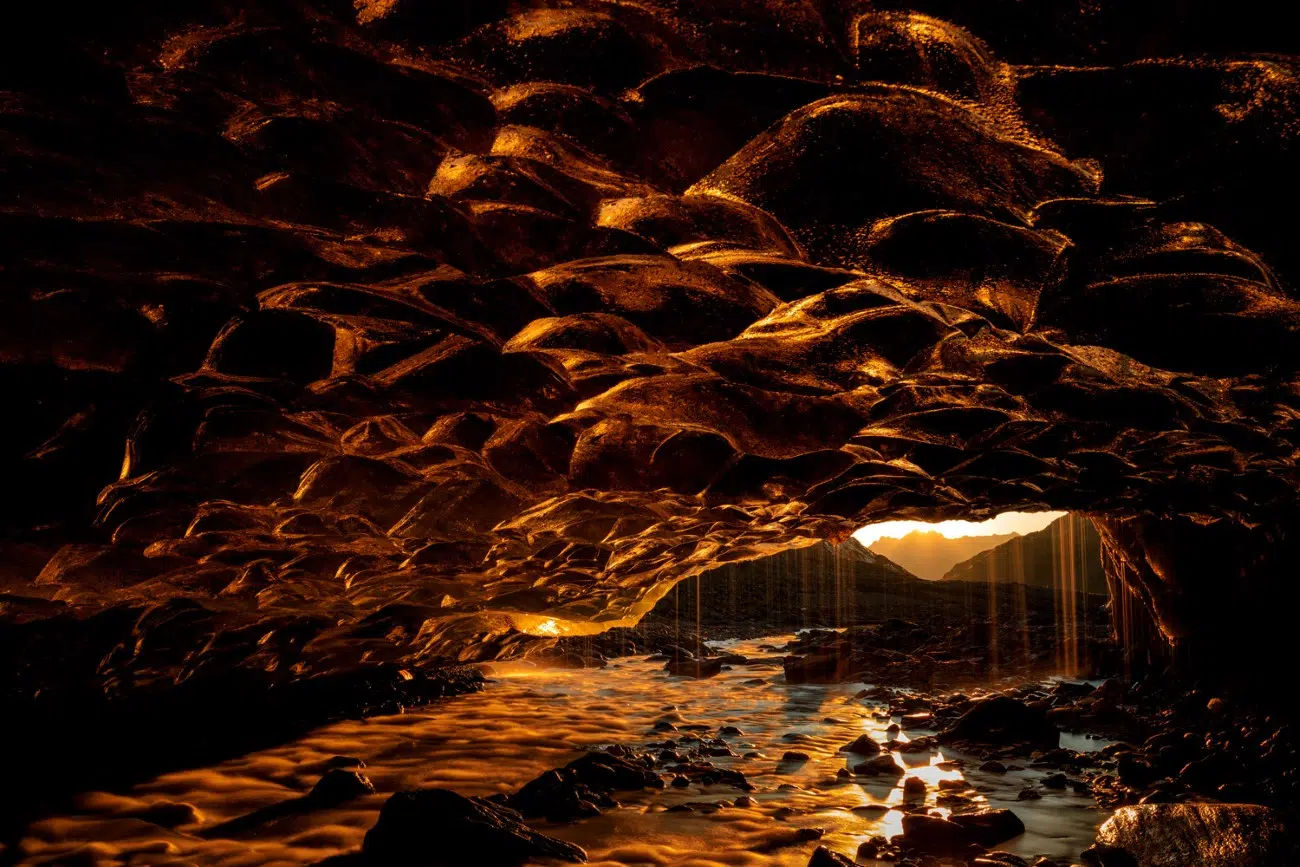
“The golden cave” by Lukas Schäfer (Italy). Highly Commended, Landscapes.
“Fine silt coats the ice of a glacier cave. The day’s last rays of sunlight strike both the cave and the meltwater flowing through its icy portal. The water, brown with sediment, reflects golden light onto the cave ceiling. The mud-coated ice enhances the hue, lending the scene a surreal quality.”
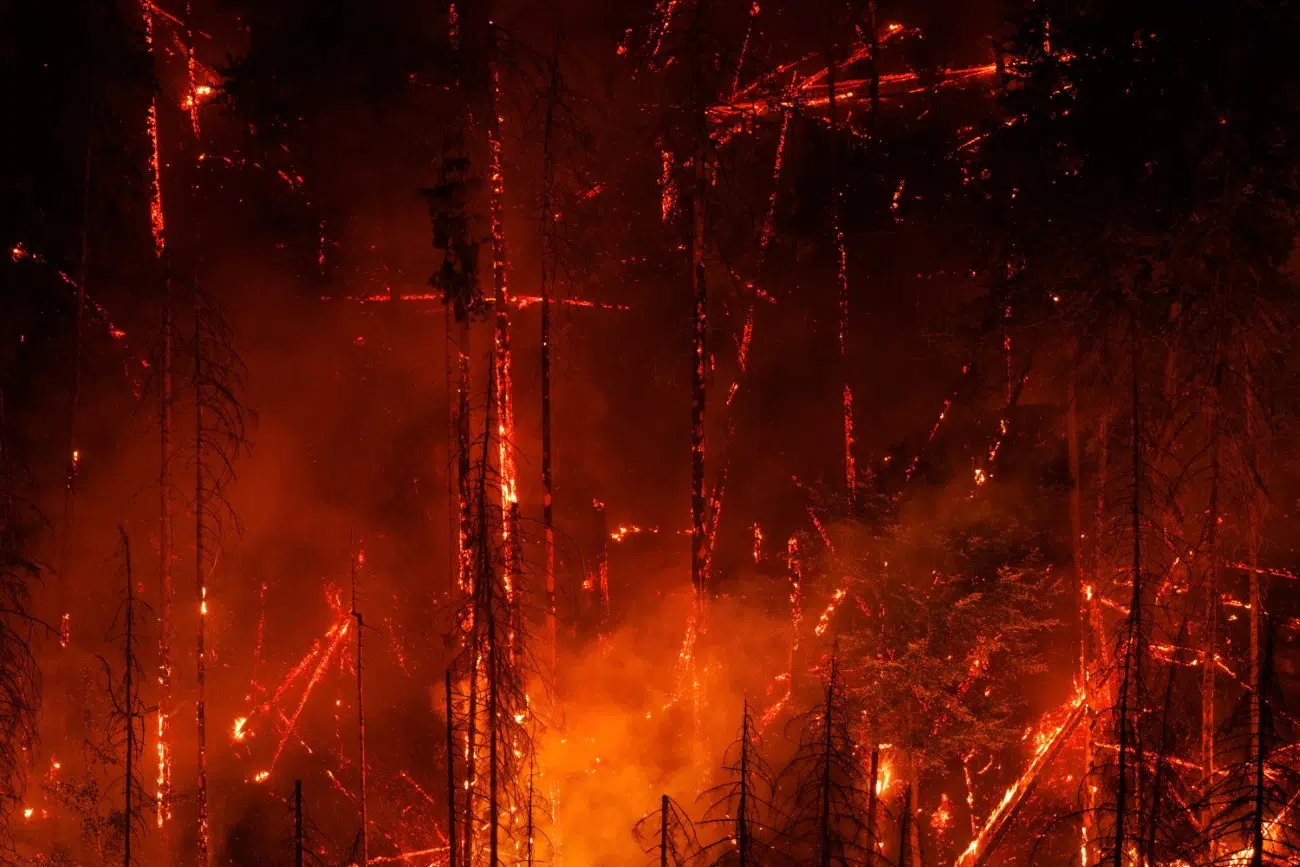
“Inferno” by Tobias Richter (Germany). Winner, Plants and Fungi.
“Blazing flames, glowing tree trunks and illuminated smoke plumes in the Elbe Sandstone Mountains on the first night of the largest forest fire ever recorded in the region. That such a large-scale natural disaster should occur exactly where I carry out my daily photographic work was inconceivable to me. Since the fire, I have documented the rapidly changing landscape, striving not only to dwell on the destruction but also highlight the gradual regeneration of nature.”

“Bloody makeup” by Amit Eshel (Israel). Highly Commended, Mammals
“On Ellesmere Island, Canada, I witnessed a harrowing scene as a pack of Arctic wolves (Canis lupus arctos) killed and devoured three newborn muskox calves right before my eyes. Afterwards, a young wolf approached my location and stared at me for a long time—an intense gaze full of intelligence and innocence. Only the blood on its brilliant white coat bore witness to the violence that had unfolded just moments earlier.”
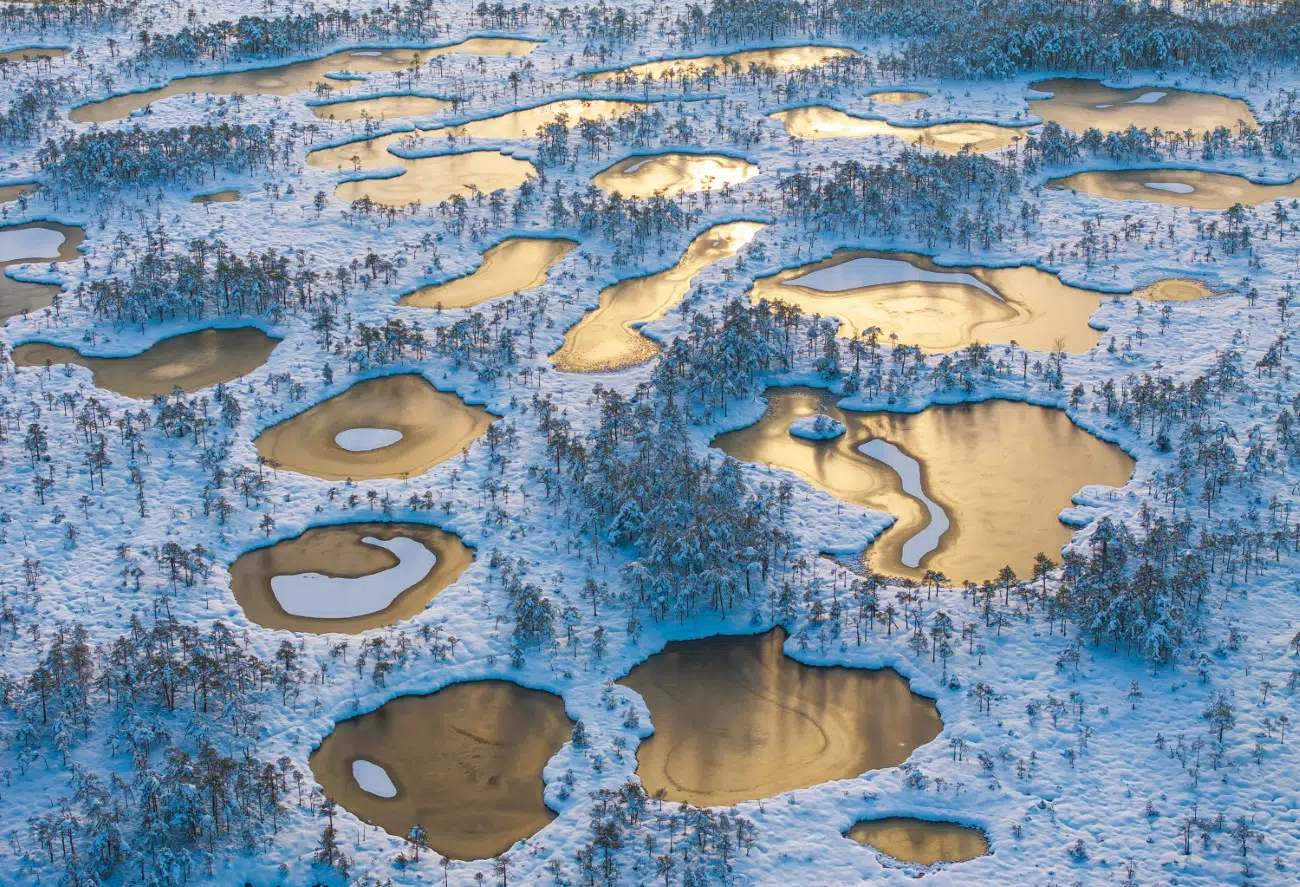
“Golden treasure” by Sven Začek (Estonia). Runner-up, Landscapes.
“Ancient Estonian folktales tell of many inexplicable phenomena associated with moors and bogs, including mysterious lights that guard a hidden treasure. Looking at these gold-shimmering frozen peat pools, one might begin to wonder whether there is some truth to these legends. Viewed more pragmatically, the golden glow stems from the clouds above that are illuminated by the low-standing sun.”
German Society for Nature Photographers (GDT): Website | Facebook | Instagram
My Modern Met granted permission to feature photos by GDT.
Related Articles:
Wildlife Photography Contest Honors the Resilience of Nature
Rare Brown Hyena Photo Wins 2025 Wildlife Photographer of the Year Competition
20 Incredible Winners From the 2023 European Wildlife Photographer of the Year Contest
Astonishing Photo of Millions of Monarch Butterflies Wins 2024 European Wildlife Photographer of the Year Contest

